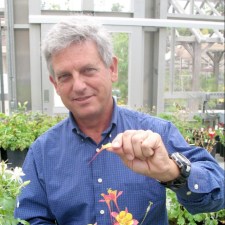UCSB Scientists Discover Example of ‘Abrupt Evolution’
Super-Fast Functional Changes in Columbine Flower Go Against Darwin’s Theory

When most people think of evolution, they think of slow changes over long periods of time. So when UCSB biologist Scott Hodges, doctoral student Zachary Cabin, and their colleagues identified a case of sudden evolutionary change in the Colorado blue columbine flower, they knew they had found something special.
In their recent paper published in Current Biology, the scientists describe a population of columbines that revealed stark differences in their petals and sepals. Rather than the five petals and five sepals of the normal flowers, the new version had 10 sepals, and their functionality was quite a bit different.

Hodges has been studying columbines for about 30 years, about as long as Cabin has been alive. When they heard rumors about the columbine variations, they decided to see them in their natural Colorado habitat the summer of 2014. They arrived in late June when the plants were flowering and returned again in early August to collect seeds for paternity analyses.
At the airport waiting for their flight, Cabin began reading off flowers numbered in their field notebook so Hodges could enter the data in his computer. Cabin was tired and just wanted to go home, but Hodges seemed to be perking up. He thought he was seeing a pattern begin to form, even from this simple seed data, which would allow them to guess if a flower was mutant. The mutant plants seemed to be much more likely to have a pollination event occur, make a fruit, and then produce seeds.
Next, they had to be sure this wasn’t just a coincidence. Cabin went back to Colorado for two more summers, and each time, his findings showed the same patterns. This was not a coincidence but a clear example of mutant genes and quick evolution.
As it turns out, the cause of this sudden change seems to all come down to a single gene, APETALA3-3, known to affect petal and sepal development. A homeotic gene, it specifies the development of an entire organ.
Sign up for Indy Today to receive fresh news from Independent.com, in your inbox, every morning.
Usually, a mutation of a homeotic gene is bad news. For example, it could cause a fly to have legs where it should have antennae. According to Hodges, most of these mutations result in a bleak outlook for the unlucky organism, with a slim chance of survival.
But every once in a while, one of these unique mutations might end up being beneficial to the organism, which would show that evolution can proceed in a positive way with single, sudden jumps.
“We did not have a good example of something positive coming from a single genetic change,” said Hodges, “until now.” Researchers must be in the right place at the right time to catch these abrupt changes as they’re happening, or they will disappear into an organism’s genome.
According to their research, about a quarter of the Colorado columbine population shows these changes in appearance and function, meaning it is more than just a chance occurrence. “To get that many of this mutant type really suggests that there’s selection favoring it somehow,” Hodges said.
There are many questions still unanswered. Given that this mutant is becoming more abundant, is it going to spread? Is it going to move to nearby populations? What is that process going to be like? Will we soon have two different widespread types of columbines? As Cabin and Hodges continue to dig into their research, they hope to find answers to these questions and more.


Support the Santa Barbara Independent through a long-term or a single contribution.




You must be logged in to post a comment.